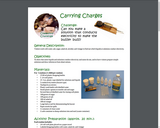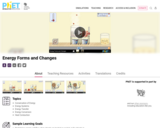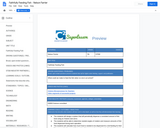
This parent guide supports parents in helping their child at home with the 6th grade Science content.
- Subject:
- Science
- Material Type:
- Reference Material
- Vocabulary
- Author:
- Kelly Rawlston
- Letoria Lewis
- Date Added:
- 10/11/2022

This parent guide supports parents in helping their child at home with the 6th grade Science content.

This resource accompanies our Rethink 6th Grade Science course. It includes ideas for use, ways to support exceptional children, ways to extend learning, digital resources and tools, tips for supporting English Language Learners and students with visual and hearing impairments. There are also ideas for offline learning.

Students use light bulbs shining on a shiny can vs a black can and a beaker of water vs a beaker of soil to compare heating and cooling rates.

In this STEM lesson, students will participate in an engineering design challenge to design and build a solar box cooker, and test it out to see if it works well enough to make S'mores.

In this activity students test a variety of liquids and solutions to see which conduct electricity. Note: This is designed for use in a science museum or education center and may need to be modified for classroom use.

In this investigation, students will work in pairs to predict, experiment, and obseve whether materials are insulators or conductors. They will complete a chart showing their results and journal about their observations, comparing them to their predictions.

Students use a simple circuit to learn how conductors allow electricity to flow and how insulators do not allow electricity to flow.

Assesses students' abilities to make and record measurements of temperature and probes their understanding of the concept of insulation. Hot water is poured into three containers (metal, ceramic, and plastic) and temperature is taken and recorded over a 10-minute interval to investigate the effect of different container materials on heat transfer and insulating capacity.

Students will observe how changes in temperature cause objects to expand or contract.

In this STEM activity, students are enabled to demonstrate, test, and analyze materials utilized in spacesuits to keep astronauts cool in the harsh environment of space. They will demonstrate the water cooling technology used in the International Space Station (ISS) Extravehicular Mobility Unit (EMU). Students will also test and make an analysis of the relationship between reflection/absorption and color.

In this STEM activity, students are provided with a variety of materials to build a hot air balloon. Teams of students will use their knowledge of density and heat transfer to design, construct, and test their balloon. The activity concludes with flight testing the balloons and then a review of the design features of all balloons for the most advantageous design features.

Sample Learning Goals
Predict how energy will flow when objects are heated or cooled, or for objects in contact that have different temperatures.
Describe the different types of energy and give examples from everyday life.
Describe how energy can change from one form of energy into another.
Explain conservation of energy in real-life systems.
Design a system with energy sources, changers, and users and describe how energy flows and changes one form of energy into another.
Tell the energy story for real-life systems.

This blog is designed for North Carolina's K-12 teachers and students who are interested in the topic of energy and alternative energy (nuclear and renewables). This blog is maintained by Dana Haine, K-12 Science Education Manager for UNC-Chapel Hill's Institute for the Environment, with funding provided by Progress Energy.

Students investigate how nature can inspire engineers. Students will use the engineering design process to design, build, and test a prototype of an underwater vehicle that can withstand both heat and cold.

Using an Arduino microprocessor, students will build an automated fish food feeder so fish can be fed when no one is at school?
This project involves learning how to do simple wiring of an LED, a buzzer, and a servo (motor) to a simple-to-use Arduino microprocessor.

Students design and build a solar water heater and see how big a temperature change they can get.

In this lesson, students explore the Moon's habitability and sustainable resources with activities that culminate with plans for the design and creation of a lunar station.

Learners will work in groups to design a water rocket that will be tested. They will be able to test two preliminary designs before deciding on the final one for the contest. Prior to launch, the rockets are put through a series of design tests. This is activity 7 of 7 in Dynamic Design: Launch and Propulsion.

This supplemental material is to be used with students for the lesson "Frozen Pucks." In this lesson, students will examine the effect of temperature on a hockey puck's elasticity by measuring the rebound height of frozen, room temperature, and warm pucks.

In this lesson, studnets will examine the effect of temperature on a hockey puck's elasticity by measuring the rebound height of frozen, room temperature, and warm pucks.